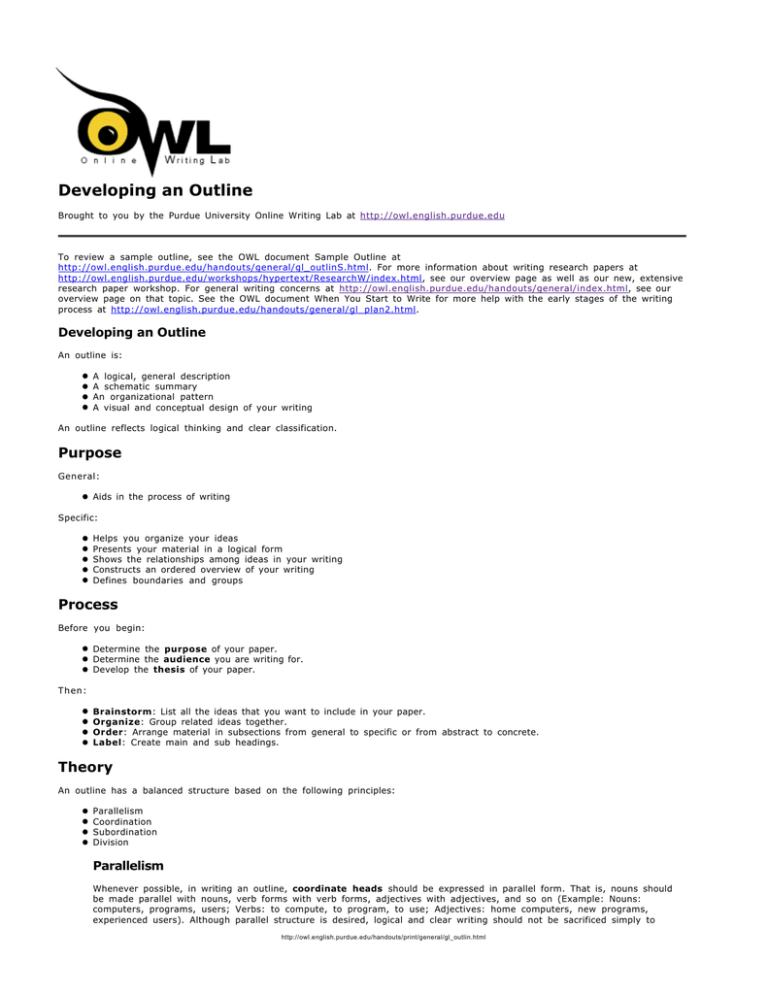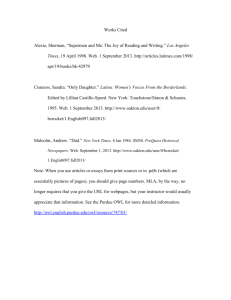
Developing an Outline
Brought to you by the Purdue University Online Writing Lab at http://owl.english.purdue.edu
To review a sample outline, see the OWL document Sample Outline at
http://owl.english.purdue.edu/handouts/general/gl_outlinS.html. For more information about writing research papers at
http://owl.english.purdue.edu/workshops/hypertext/ResearchW/index.html, see our overview page as well as our new, extensive
research paper workshop. For general writing concerns at http://owl.english.purdue.edu/handouts/general/index.html, see our
overview page on that topic. See the OWL document When You Start to Write for more help with the early stages of the writing
process at http://owl.english.purdue.edu/handouts/general/gl_plan2.html.
Developing an Outline
An outline is:
A logical, general description
A schematic summary
An organizational pattern
A visual and conceptual design of your writing
An outline reflects logical thinking and clear classification.
Purpose
General:
Aids in the process of writing
Specific:
Helps you organize your ideas
Presents your material in a logical form
Shows the relationships among ideas in your writing
Constructs an ordered overview of your writing
Defines boundaries and groups
Process
Before you begin:
Determine the purpose of your paper.
Determine the audience you are writing for.
Develop the thesis of your paper.
Then:
Brainstorm: List all the ideas that you want to include in your paper.
Organize: Group related ideas together.
Order: Arrange material in subsections from general to specific or from abstract to concrete.
Label: Create main and sub headings.
Theory
An outline has a balanced structure based on the following principles:
Parallelism
Coordination
Subordination
Division
Parallelism
Whenever possible, in writing
be made parallel with nouns,
computers, programs, users;
experienced users). Although
an outline, coordinate heads should be expressed in parallel form. That is, nouns should
verb forms with verb forms, adjectives with adjectives, and so on (Example: Nouns:
Verbs: to compute, to program, to use; Adjectives: home computers, new programs,
parallel structure is desired, logical and clear writing should not be sacrificed simply to
http://owl.english.purdue.edu/handouts/print/general/gl_outlin.html
maintain parallelism. (For example, there are times when nouns and gerunds at the same level of an outline are
acceptable.) Reasonableness and flexibility of form is preferred to rigidity.
Coordination
In outlining, those items which are of equal significance have comparable numeral or letter designations: an A is equal
to a B , a 1 to a 2 , an a to a b , etc. Coordinates should be seen as having the same value. Coordination is a principle
that enables a writer to maintain a coherent and consistent document.
Correct coordination
A. Word processing programs
B. Database programs
C. Spreadsheet programs
Faulty coordination
A. Word processing programs
B. Microsoft Word
C. Page Maker
Explanation : Word is a type of word processing program and should be treated as a subdivision. Page Maker is a type of
desktop publishing program. One way to correct coordination would be:
A. Types of programs
1. Word processing
2. Desktop publishing
B. Evaluation of programs
1. Word processing
a. Word
b. Word Perfect
2. Desktop Publishing
a. Page Maker
b. Quark Express
Subordination
In order to indicate levels of significance, an outline uses major and minor headings. Thus in ordering ideas, you should
organize it from general to specific or from abstract to concrete- the more general or abstract the term, the higher the
level or rank in the outline. This principle allows your material to be ordered in terms of logic and requires a clear
articulation of the relationship between component parts used in the outline. Subdivisions of each higher division should
always have the same relationship to the whole.
Correct subordination
A. Word processing programs
1. Microsoft Word
2. Word Perfect
B. Desktop publishing programs
1. PageMaker
2. Quark Express
Faulty subordination
A. Word processing programs
1. Word
2. Useful
3. Obsolete
Explanation : There is an A without a B . Also 1, 2, and 3 are not equal; Word is a type of word processing program, and
useful and obsolete are qualities. One way to correct this faulty subordination is:
A. Word
1. Positive features
2. Negative features
B. Word Perfect
1. Positive features
2. Negative features
Division
To divide you always need at least two parts; therefore, there can never be an A without a B , a 1 without a 2 , an a
without a b , etc. Usually there is more than one way to divide parts; however, when dividing use only one basis of
division at each rank, and make the basis of division as sharp as possible.
Correct division
A. Personal computers: hardware
1. Types
2. Cost
3. Maintenance
http://owl.english.purdue.edu/handouts/print/general/gl_outlin.html
B. Personal computers: software
Faulty division
A. Computers
1. Mainframe
2. Micro
a. Floppy disk
b. Hard disk
B. Computer uses
1. Institutional
2. Personal
Form
The most important rule for outlining form is to be consistent!
An outline can use topic or sentence structure.
A topic outline uses words or phrases for all entries and uses no punctuation after entries.
Advantages: presents a brief overview of work and is generally easier and faster to write than a
sentence outline.
A sentence outline uses complete sentences for all entries and uses correct punctuation.
Advantages: presents a more detailed overview of work including possible topic sentences and is
easier and faster for writing the final paper.
An outline can use Roman numerals/letters or decimal form.
Roman Numeral
I.
A.
B.
1.
2.
a.
b.
Decimal
1.0
1.1
1.2
1.2.1
1.2.2
1.2.2.1
1.2.2.2
See OWL handout for a sample outline at http://owl.english.purdue.edu/handouts/general/gl_outlinS.html.
http://owl.english.purdue.edu/handouts/print/general/gl_outlin.html
The following information must remain intact on every handout printed for distribution.
This page is located at http://owl.english.purdue.edu/handouts/print/general/gl_outlin.html
Copyright ©1995-2001 by OWL at Purdue University and Purdue University. All rights reserved.
Use of this site, including printing and distributing our handouts, constitutes acceptance of our terms and conditions of fair use,
available at
http://owl.english.purdue.edu/lab/fairuse.html.
To contact OWL, please visit our contact information page at
http://owl.english.purdue.edu/lab/contact.html to find the right person to call or email.
http://owl.english.purdue.edu/handouts/print/general/gl_outlin.html


